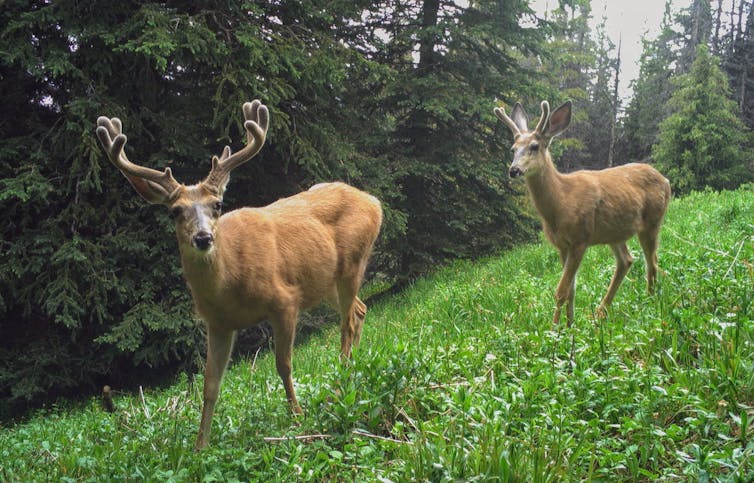The COVID-19 pandemic changed our patterns and behaviours, which in turn affected wildlife

By Cole Burton, University of British Columbia
The Earth now supports over eight billion people who collectively have transformed three-quarters of the planet’s land surface for food, energy, shelter and other aspects of the human enterprise.
Wild animals must not only contend with how their habitats have been changed, but also endure the increasing presence of people in almost all environments, from expanding wildland-urban interfaces to the frontiers of outdoor recreation and nature-based tourism.
We are in the midst of a global biodiversity crisis, with high extinction rates and many wildlife populations showing clear evidence of decline (such as caribou and lions).
As a wildlife ecologist and conservation biologist, I am concerned that we are putting the squeeze on wildlife in ways that can increase conflicts and displace animals from the habitats they need.
Observing animal behaviour
If we are to protect the animals we treasure for their ecological, economic and cultural values, we must find ways to promote human-wildlife coexistence. To successfully adapt our own behaviours, we must also understand whether and how animals can adapt to us.
Two key challenges have limited this understanding. First, it is hard to observe animals in the wild. Encounters are rare because animals are elusive, and the mere presence of a human observer may influence our understanding.
Second, it is not generally feasible to conduct experiments — hallmarks of rigorous science — that manipulate human activities in varied contexts. In a recent study published in Nature Ecology and Evolution, my colleagues and I set out to tackle these challenges by using the COVID-19 pandemic as a form of “unplanned experiment.”
The pandemic was a tragedy, but it created a rare opportunity to learn about human-wildlife interactions. Government lockdowns to stem the spread of the virus forced us to stay close to home, drastically changing our typical movement patterns.
This “anthropause” spurred scientists to ask how animals responded — our curiosities were piqued by unusual sightings.
Captured images
Our team recognized that such anecdotal observations could be prone to biases; we sought a more systematic approach to cover a wide range of species and locations while overcoming the elusive nature of wild animals. The popularity of motion-triggered wildlife camera traps has made it much easier to glimpse into the secret lives of animals.
These remote cameras work diligently to capture photographs of animals — including humans — that wander past, without the need for observers to be physically present.
Recognizing this opportunity, we assembled a team of more than 200 scientists from 21 countries that were monitoring mammals before and during the lockdowns. We sifted through millions of images of 163 species of wild mammals, collected from more than 5,000 camera traps. After estimating changes in the amount and timing of activity for animals as small as snowshoe hares and as big as African elephants, some striking patterns emerged.
Contrary to popular narratives, we did not see an overall trend of wildlife running free while humans sheltered in place.
Rather, we saw great variation in the activity of people and wildlife. While some areas emptied of people as parks closed, others saw increases in use, such as urban greenspaces or rural refuges where people sought solace from pandemic pressures.
Comfort with humans
Animals had a wide range of reactions to the changes in human activity, with the strongest pattern being that their responses depended on their position in the food chain and the condition of the landscape. Predator species, like wolves and wolverines, tended to be warier of people, reducing their activity when more people were around and being lost altogether from the busiest areas.
By contrast, prey species, including large herbivores like deer or moose, often increased activity when more people were around, potentially to take advantage of the “human shield” that deterred predators.
Notably, animals living in wilder landscapes were more sensitive to increases in human activity, while their urban cousins tended to be more tolerant but shifted to being more active at night. This highlights that even within the same species, animals can have different responses to people depending on where they live.
We believe that wildlife managers should take note of these results. Levels of outdoor recreation and other human endeavours may need to be carefully managed in wildland landscapes to avoid displacing the sensitive animals that depend on these more remote areas.
While in more modified landscapes — such as near cities and farms — animals may become habituated to humans, even attracted to “free food” like garbage or gardens, while working to avoid conflicts by moving frequently and using the cover of darkness.
Human-wildlife coexistence in these developed areas requires care to remove unhealthy attractants that may promote conflict, while limiting disturbances at night so animals can access the food, cover and mates that they need to persist.
Overall, our study highlights the tremendous complexity of animal behaviours, and the fact that there are no silver bullets when it comes to coexistence. It is clear that animals are working hard to adapt to humanity’s ever-expanding presence, and that we need to do our part to ensure we can keep sharing space with the wildlife we cherish.
Establishing and maintaining effective biodiversity monitoring systems, including the camera trap surveys that underpinned our analysis, will be critical as we strive to understand and steward our ever-changing ecosystems.![]()
Cole Burton, Canada Research Chair in Terrestrial Mammal Conservation, University of British Columbia
This article is republished from The Conversation under a Creative Commons license. Read the original article.



